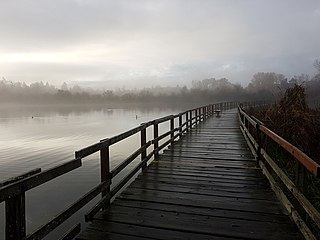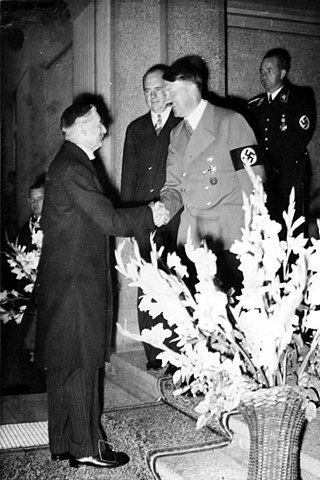
The Sudetenland is the historical German name for the northern, southern, and western areas of former Czechoslovakia which were inhabited primarily by Sudeten Germans. These German speakers had predominated in the border districts of Bohemia, Moravia, and Czech Silesia since the Middle Ages. Since the 9th century the Sudetenland had been an integral part of the Czech state both geographically and politically.

The Munich Agreement was an agreement reached in Munich on 30 September 1938, by Nazi Germany, the United Kingdom, the French Republic, and Fascist Italy. The agreement provided for the German annexation of part of Czechoslovakia called the Sudetenland, where more than three million people, mainly ethnic Germans, lived. The pact is also known in some areas as the Munich Betrayal, because of a previous 1924 alliance agreement and a 1925 military pact between France and the Czechoslovak Republic.

The Okanagan, also called the Okanagan Valley and sometimes the Okanagan Country, is a region in the Canadian province of British Columbia defined by the basin of Okanagan Lake and the Canadian portion of the Okanagan River. It is part of the Okanagan Country, extending into the United States as Okanogan County in north-central Washington. According to the 2016 Canadian census, the region's population is 362,258. The largest populated cities are Kelowna, Penticton, Vernon, and West Kelowna.

Konrad Ernst Eduard Henlein was a Sudeten German politician in Czechoslovakia before World War II. After Germany invaded Czechoslovakia he became the Gauleiter and Reichsstatthalter of Reichsgau Sudetenland under the occupation of Nazi Germany.

The Peace River is a 1,923-kilometre-long (1,195 mi) river in Canada that originates in the Rocky Mountains of northern British Columbia and flows to the northeast through northern Alberta. The Peace River joins the Athabasca River in the Peace-Athabasca Delta to form the Slave River, a tributary of the Mackenzie River. The Finlay River, the main headwater of the Peace River, is regarded as the ultimate source of the Mackenzie River. The combined Finlay–Peace–Slave–Mackenzie river system is the 13th longest river system in the world.

The Flathead River, in the northwestern part of the U.S. state of Montana, originates in the Canadian Rockies to the north of Glacier National Park and flows southwest into Flathead Lake, then after a journey of 158 miles (254 km), empties into the Clark Fork. The river is part of the Columbia River drainage basin, as the Clark Fork is a tributary of the Pend Oreille River, a Columbia River tributary. With a drainage basin extending over 8,795 square miles (22,780 km2) and an average discharge of 11,380 cubic feet per second (322 m3/s), the Flathead is the largest tributary of the Clark Fork and constitutes over half of its flow.

German Bohemians, later known as Sudeten Germans, were ethnic Germans living in the Czech lands of the Bohemian Crown, which later became an integral part of Czechoslovakia. Before 1945, over three million German Bohemians constituted about 23% of the population of the whole country and about 29.5% of the population of Bohemia and Moravia. Ethnic Germans migrated into the Kingdom of Bohemia, an electoral territory of the Holy Roman Empire, from the 11th century, mostly in the border regions of what was later called the "Sudetenland", which was named after the Sudeten Mountains.

Albert Park is a large public park in the City of Port Phillip, an inner suburban LGA of Melbourne, Victoria, Australia. Located 3 km (1.9 mi) south of the Melbourne central business district, the park encompasses 2.25 km2 of parkland around the 1.8 km (1.1 mi) long Albert Park Lake, a 0.49 km2 Y-shaped artificial lake used both for water sports and public recreation.

Saskatoon Island Provincial Park is a provincial park located in northern Alberta, Canada. It is located 20 kilometers (12 mi) west of Grande Prairie in the Peace River Country, on the southern shore of Saskatoon Lake.

The Spruce Lake Protected Area, formerly known variously as the Southern Chilcotin Mountains Provincial Park, Southern Chilcotins, and also as South Chilcotin Provincial Park, is a 71,347-hectare Protected Area in the British Columbia provincial parks system, approximately 200 km north of Vancouver. The area had been the subject of an ongoing preservationist controversy since the 1930s. In 2007, its status as a provincial park was downgraded to protected area.

Sudeten Provincial Park is a former provincial park in British Columbia, Canada. Ownership of the five-hectare park was transferred from the provincial government to local government for park purposes in 2006. It is now known as Sudeten Heritage Park and operated by Tomslake & District Recreation Commission.
Tweedsmuir South Provincial Park is a provincial park covering parts of the eastern Kitimat Ranges, northern Pacific Ranges, and the Rainbow Range in British Columbia, Canada. It was established on May 21, 1938 in the western interior of the province, to protect its important natural features. The park hosts a variety of recreation activities for visitors. This park encompasses a range of diverse species in this park including bears, moose, and various fish. There are also a few at risk species in this park.

Iona Island in Richmond, British Columbia, Canada was formerly an island, but is now a peninsula physically connected to Sea Island via a causeway and Ferguson Road. Iona is home to a primary sewage treatment plant, an animal refuge and a park. The Iona Sewage Plant is located near the centre of the island and has tours for the public. Iona Beach Regional Park also features a beach adjacent to wildlife from the nearby animal refuge. The park is managed by Metro Vancouver. Iona Island is located almost adjacent to the Vancouver International Airport. The park is mostly visited by birders, as the sewage ponds have attracted many rare shorebirds such as Spoon-billed Sandpiper, Great Knot, and Red-necked Stint.

Swan Lake Christmas Hill Nature Sanctuary is a nature reserve located in Saanich, British Columbia. The sanctuary includes a lake, adjacent marshy lowlands, and the Nature House, as well as a good part of the summit regions of Christmas Hill.

Vaseux Lake is a shallow freshwater lake located along the course of the Okanagan River in the Okanagan Valley of British Columbia, Canada.

The Godesberg Memorandum is a document issued by Adolf Hitler in the early hours of 24 September 1938 concerning the Sudetenland and amounting to an ultimatum addressed to the government of Czechoslovakia.
The Carlsbad Programme was an eight-point series of demands, addressed to the government of Czechoslovakia, issued by Konrad Henlein, the leader of the Sudeten German Party (SdP), at a party gathering in Carlsbad on 24 April 1938.The programme demanded full autonomy for the mainly German-inhabited areas of Czechoslovakia, known as the Sudetenland. Under pressure from its allies, Britain and France, the Czechoslovak government reluctantly accepted the demands. But the SdP, instructed by Nazi Germany not to reach a settlement with the Czechoslovak authorities, broke off negotiations, thus precipitating the Munich crisis.

The Holocaust in the Sudetenland resulted in the flight, dispossession, deportation and ultimately death of many of the 24,505 Jews living in the Reichsgau Sudetenland, an administrative region of Nazi Germany established from former Czechoslovak territory annexed after the October 1938 Munich Agreement. Due to harassment and violence, including during Kristallnacht, ninety percent of the Jews had already left the Sudetenland by mid-1939. The remaining Jews were subject to property confiscation and eventually deportation. During the later years of the war, tens of thousands of Jews and non-Jews were forced laborers in a network of concentration camps in the Sudetenland.

















